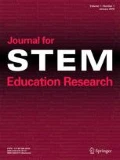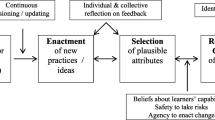Abstract
A need exists for impactful interdisciplinary collaborations between STEM and Education departments to build successful STEM teacher education programs. Within extant literature, few studies have examined the qualities that make STEM and Education collaborations possible for the purpose of STEM teacher preparation. The purpose of this study was to analyze the motivation, development and sustainability of collaborations between STEM and Education faculty and university supervisors to better enhance STEM teacher education programs. This study analyzes the dynamics between STEM and Education faculty and university supervisors at seven universities with Robert Noyce Teacher Scholarship Programs within the state of Texas. Through a qualitative multiple-case study research approach, we collected data through focus group interviews, archival information, and field notes. Our exploratory study yielded three main findings to include the following: (1) characteristics of impactful STEM-Education collaborations; (2) impact of STEM-Education collaborations; and (3) common STEM-Education collaboration constraints. Based on the findings from this study, implications for universities, institutional leaders, students, and the grant foundation are discussed.

Similar content being viewed by others
References
Amey, M. J., & Brown, D. F. (2004). Breaking out of the box: Interdisciplinary collaboration and faculty work. Charlotte: Information Age Publishing.
Amey, M. J., Eddy, P. L., & Ozaki, C. C. (2007). Demands for partnership and collaboration in higher education: A model. New directions for community colleges, (139), 5–14.
Bogdan, R. C., & Biklen, S. K. (1992). Qualitative research for education: An introduction to theory and methods (2nd ed.). Needham Heights: Allyn and Bacon.
Bouwma-Gearhart, J., & Adumat, S. (2011). Fostering successful interdisciplinary postsecondary faculty collaborations. International Journal of University Teaching and Faculty Development, 2, 207–220.
Bouwma-Gearhart, J., Perry, K., & Presley, J. (2014). Improving postsecondary STEM education: Strategies for successful interdisciplinary collaborations and brokering engagement with education research and theory. Journal of College Science Teaching, 44(1), 40–47 Retrieved from http://www.jstor.org.ezproxy.lib.uh.edu/stable/43631776.
Charmaz, K. (2006). Constructing grounded theory: A practical guide through qualitative analysis. Thousand Oaks: Sage.
Collins, A., Bercaw, L., Palmeri, A., Altman, J., & Singer-Gabella, M. (1999). Good intentions are not enough: A story of collaboration in science, education, and technology. Journal of Science Teacher Education, 10(1), 3–20.
Cook, B. & Pullaro, N. (2010). College graduation rates: Behind the numbers. American Council on Education. Retrieved from http://www.acenet.edu/news-room/Documents/College-Graduation-Rates-Behind-the-Numbers.pdf.
Craig, C. J., Evans, P., Bott, S., Stokes, D., & Abrol, B. (2017). Attracting, preparing, and retaining teachers in high need areas: A science as inquiry model of teacher education. In M. Peters, B. Cowie, & I. Mentor (Eds.), A companion to research in teacher education (pp. 455–470). New York: Springer Publishing.
Czworkowski, J., & Seethaler, S. (2013). Content-intensive courses in an undergraduate science education minor and impacts on participating students. Journal of College Science Teaching, 43(1), 48–53 Retrieved from http://www.jstor.org/stable/43631721.
Denzin, N. K., & Lincoln, Y. S. (Eds.). (1994). Handbook of qualitative research. Thousand Oaks: Sage.
Eddy, P. (2010). Partnerships and collaborations in higher education. ASHE Higher Education Report, 36, 1–115.
Education Code. (1971). Title 3. Higher Education. Section 61.003. Retrieved from http://www.statutes.legis.state.tx.us/Docs/ED/htm/ED.54.htm
Geertz, C. (Ed.). (1973). The interpretation of cultures. New York: Basic Books.
Glazer, N. (1974). The schools of the minor professions. Minerva, 12(3), 346–364 https://doi-org.ezproxy.lib.uh.edu/10.1007/BF01102529.
Holley, K. (2009). Understanding interdisciplinary challenges and opportunities in higher education. ASHE Higher Education Report, 35(2), 1–131.
Hubbard, K., Embry-Jenlink, K., & Beverly, L. (2015). A university approach to improving STEM teacher recruitment and retention. Kappa Delta Pi Record, 51(2), 69–74.
Joshi, A., Pandey, N., & Han, G. (2009). Bracketing team boundary spanning: An examination of task-based, team-level, and contextual antecedents. Journal of Organizational Behavior, 30(6), 731–759 Retrieved from http://www.jstor.org/stable/41683864.
Kezar, A. (2005a). Moving from I to, reorganizing for collaboration in higher education. Change: The Magazine of Higher Learning, 37(6), 50–57.
Kezar, A. (2005b). Redesigning for collaboration within higher education institutions: An exploration into the developmental process. Research in Higher Education, 46(7), 831–860. https://doi.org/10.1007/s11162-004-6227-5.
Kezar, A. J., & Lester, J. (2009). Organizing higher education for collaboration: A guide for campus leaders. San Francisco: Jossey-Bass.
King, J. (1987). The uneasy relationship between teacher education and the liberal arts and sciences. Journal of Teacher Education, 31(1), 6–10.
Labaree, D. (2008). An uneasy relationship: The history of teacher education in the university. In M. Cochran-Smith, S. Feiman-Nemser, & J. McIntyre (with K. Demers) (Eds.), Handbook of research on teacher education (3rd ed., pp. 290–306). New York: Routledge.
Lattuca, L. R. (2003). Creating interdisciplinarity: Grounded definitions from college and university faculty. History of Intellectual Culture, 3(1) Retrieved from: https://www.ucalgary.ca/hic/files/hic/lattucapdf.pdf.
Leech, N. L., & Onwuegbuzie, A. J. (2011). Beyond constant comparison qualitative data analysis: Using NVivo. School Psychology Quarterly, 26(1), 70–84.
Lincoln, Y. S., & Guba, E. G. (1985). Naturalistic inquiry. Beverly Hills: Sage.
McAlister-Shields, L., Dickerson, S. H., Denham, M. A., & Onwuegbuzie, A. J. (2015). A mixed research meta-framework for conducting focus groups. Training Session conducted at the 37th Annual Meeting of the Southwest Educational Research Association (SERA), San Antonio.
McCoy, S. K., & Gardner, S. K. (2012). Interdisciplinary collaboration on campus: Five questions. Change: The Magazine of Higher Learning, 44(6), 44–49.
Miles, M. B., & Huberman, A. M. (1994). Qualitative data analysis: An expanded sourcebook (2nd ed.). Thousand Oaks: Sage.
National Science Foundation. (2017a). Robert Noyce teacher scholarship program Retrieved from http://nsfnoyce.org/
National Science Foundation. (2017b). Robert Noyce teacher scholarship program, program solicitation. Retrieved from https://www.nsf.gov/pubs/2017/nsf17541/nsf17541.htm
Onwuegbuzie, A. J., & Leech, N. L. (2007). Sampling Designs in Qualitative Research: Making the Sampling Process More Public. The Qualitative Report, 12(2), 238-254.
Patton, M. Q. (2002). Qualitative research and evaluation methods (3rd ed.). Thousand Oaks, CA: Sage.
Ramaley, J. A. (2014). The changing role of higher education: Learning to deal with wicked problems. Journal of Higher Education Outreach and Engagement, 18(3), 7–22.
Ravitch, D. (2003). A brief history of teacher professionalism. Paper presented at the White House Conference on Preparing Tomorrow’s Teachers, Washington, DC.
Sack, J., Quander, J., Redl, T., & Leveille, N. (2015). The community of practice among mathematics and mathematics education faculty members at an urban minority serving institution in the US. Innovative Higher Education, 41(2), 167–182.
Saldaña, J. (2009). The coding manual for qualitative researchers. Thousand Oaks: Sage.
Sanders, M. (2009). STEM, STEM education, STEMmania. The Technology Teacher, 20–26 Retrieved from http://hdl.handle.net/10919/51616.
Schwebel, M. (1985). The clash of cultures in academe: The university and the education faculty. Journal of Teacher Education, 36(4), 2–7.
Seethaler, S., Czworkowski, J., Remmel, J., Sawrey, B., & Souviney, R. (2013). Bridging the divide between science and education: Lessons from a fruitful collaboration. Journal of College Science Teaching, 43(1), 54–59 Retrieved from http://www.jstor.org/stable/43631722.
Talanquer, V., Novodvorsky, I., Slater, T. F., & Tomanek, D. (2003). A stronger role for science departments in the preparation of future chemistry teachers. Journal of Chemical Education, 80(10), 1168–1171.
U.S. Department of Education. (2014). Texas 2014 Title 2 report. Retrieved from https://title2.ed.gov/Public/Report/StateHome.aspx.
Watt, H., & Richardson, P. (2008). Motivations, perceptions, and aspirations concerning teaching as a career for different types of beginning teachers. Learning and Instruction, 18, 408–428.
Yin, R. K. (2003). Case study research: Design and methods (3rd ed.). Thousand Oaks: Sage Publications.
Acknowledgements
This article includes findings from the following National Science Foundation Noyce Grant Programs: 1557273, 1136416, 1556983, 0934878, 1439861, 1239993, 1557405, 1240036, 1240038, 0934913, 1540769, 1136222, 1439914, 1035483, 1612380, 0833343, 0334811, 0630376, 1557155, 0833342, 1557309 and 1240083. All errors or omissions are the responsibility of the authors, not of the funding agency.
We want to thank Cathy Horn, Andrea Burridge, and Cheryl Craig for their feedback on earlier drafts.
Funding
1557273.
Author information
Authors and Affiliations
Corresponding author
Ethics declarations
Conflict of Interest
Dr. Paige Evans has received research grants from the National Science Foundation. Dr. Paige Evans declares that there is no conflict of interest.
Confirmation
We confirm that this work is original and has not been published or being considered for publication elsewhere. We also confirm that all authors have approved this manuscript for submission.
Additional information
Publisher’s Note
Springer Nature remains neutral with regard to jurisdictional claims in published maps and institutional affiliations.
Appendix
Appendix
Interview Protocol
Focus Group Interview Questions (Faculty and Staff):
-
1.
What has been most helpful in supporting efforts to recruit students into teaching?
-
2.
What challenges have you experienced in recruiting STEM majors into teaching careers, and what has helped to address those challenges?
-
3.
What components of your STEM teacher preparation program do you believe have been most useful in preparing students to go into K-12 classrooms?
-
4.
What components of your STEM teacher preparation program do you believe have been most useful in preparing students to teach diverse learners as well as teach in different school environments?
-
5.
Describe any components that may have interfered in preparing students to do well (field placement, course-work, etc.).
-
6.
What has been challenging in placing students in the field and/or your field placement structure and how have you dealt with these challenges?
-
7.
Which collaborative partnerships have worked well and which partnerships have not worked as well? What affected these outcomes?
-
8.
What have you gained by partnering with local schools for field placements?
-
9.
What can be done to enhance the value of the experiences your students have in their preparation to become STEM teachers?
-
10.
How did other STEM and Education faculty, as well as administrators and campus leaders support your Noyce project?
-
11.
How did your STEM or Teacher preparation programs benefit as a result of the college’s Noyce Program?
Thank you for your time and thoughtful comments. Are there any other comments, questions, or information that you would like to provide before we end our session?
Rights and permissions
About this article
Cite this article
Evans, P.K., Dillard, K.C., Rodriguez-Wilhelm, D. et al. Like-Minded People: University-Based Interdisciplinary Collaborations in STEM Teacher Preparation Programs. Journal for STEM Educ Res 2, 35–54 (2019). https://doi.org/10.1007/s41979-019-00011-0
Published:
Issue Date:
DOI: https://doi.org/10.1007/s41979-019-00011-0




